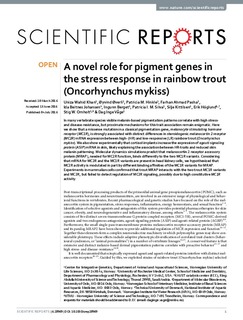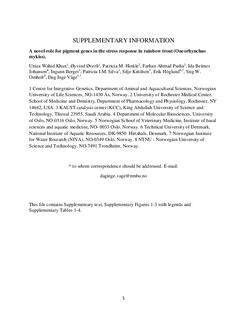| dc.contributor.author | Kahn, Uniza Wahid | |
| dc.contributor.author | Øverli, Øyvind | |
| dc.contributor.author | Hinkle, Patricia M. | |
| dc.contributor.author | Pasha, Farhan Ahmad | |
| dc.contributor.author | Johansen, Ida Beitnes | |
| dc.contributor.author | Berget, Ingunn | |
| dc.contributor.author | Silva, Patricia | |
| dc.contributor.author | Kittilsen, Silje | |
| dc.contributor.author | Höglund, Erik | |
| dc.contributor.author | Omholt, Stig William | |
| dc.contributor.author | Våge, Dag Inge | |
| dc.date.accessioned | 2016-09-07T08:16:05Z | |
| dc.date.accessioned | 2016-09-09T11:14:37Z | |
| dc.date.available | 2016-09-07T08:16:05Z | |
| dc.date.available | 2016-09-09T11:14:37Z | |
| dc.date.issued | 2016 | |
| dc.identifier.citation | Scientific Reports 2016, 6:28969 | nb_NO |
| dc.identifier.issn | 2045-2322 | |
| dc.identifier.uri | http://hdl.handle.net/11250/2405778 | |
| dc.description.abstract | In many vertebrate species visible melanin-based pigmentation patterns correlate with high stress- and disease-resistance, but proximate mechanisms for this trait association remain enigmatic. Here we show that a missense mutation in a classical pigmentation gene, melanocyte stimulating hormone receptor (MC1R), is strongly associated with distinct differences in steroidogenic melanocortin 2 receptor (MC2R) mRNA expression between high- (HR) and low-responsive (LR) rainbow trout (Oncorhynchus mykiss). We also show experimentally that cortisol implants increase the expression of agouti signaling protein (ASIP) mRNA in skin, likely explaining the association between HR-traits and reduced skin melanin patterning. Molecular dynamics simulations predict that melanocortin 2 receptor accessory protein (MRAP), needed for MC2R function, binds differently to the two MC1R variants. Considering that mRNA for MC2R and the MC1R variants are present in head kidney cells, we hypothesized that MC2R activity is modulated in part by different binding affinities of the MC1R variants for MRAP. Experiments in mammalian cells confirmed that trout MRAP interacts with the two trout MC1R variants and MC2R, but failed to detect regulation of MC2R signaling, possibly due to high constitutive MC1R activity. | nb_NO |
| dc.language.iso | eng | nb_NO |
| dc.publisher | Nature Publishing Group | nb_NO |
| dc.rights | Navngivelse 3.0 Norge | * |
| dc.rights.uri | http://creativecommons.org/licenses/by/3.0/no/ | * |
| dc.title | A novel role for pigment genes in the stress response in rainbow trout (Oncorhynchus mykiss) | nb_NO |
| dc.type | Journal article | nb_NO |
| dc.type | Peer reviewed | nb_NO |
| dc.date.updated | 2016-09-07T08:16:05Z | |
| dc.source.journal | Scientific Reports | nb_NO |
| dc.identifier.doi | 10.1038/srep28969 | |
| dc.identifier.cristin | 1375657 | |
| dc.description.localcode | This work is licensed under a Creative Commons Attribution 4.0 International License. The images or other third party material in this article are included in the article’s Creative Commons license, unless indicated otherwise in the credit line; if the material is not included under the Creative Commons license, users will need to obtain permission from the license holder to reproduce the material. To view a copy of this license, visit http://creativecommons.org/licenses/by/4.0/ | nb_NO |


